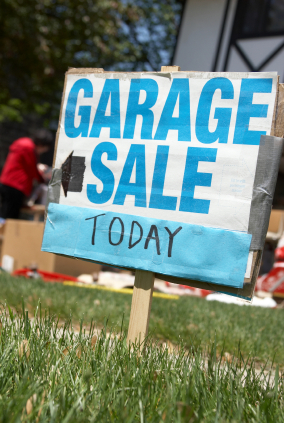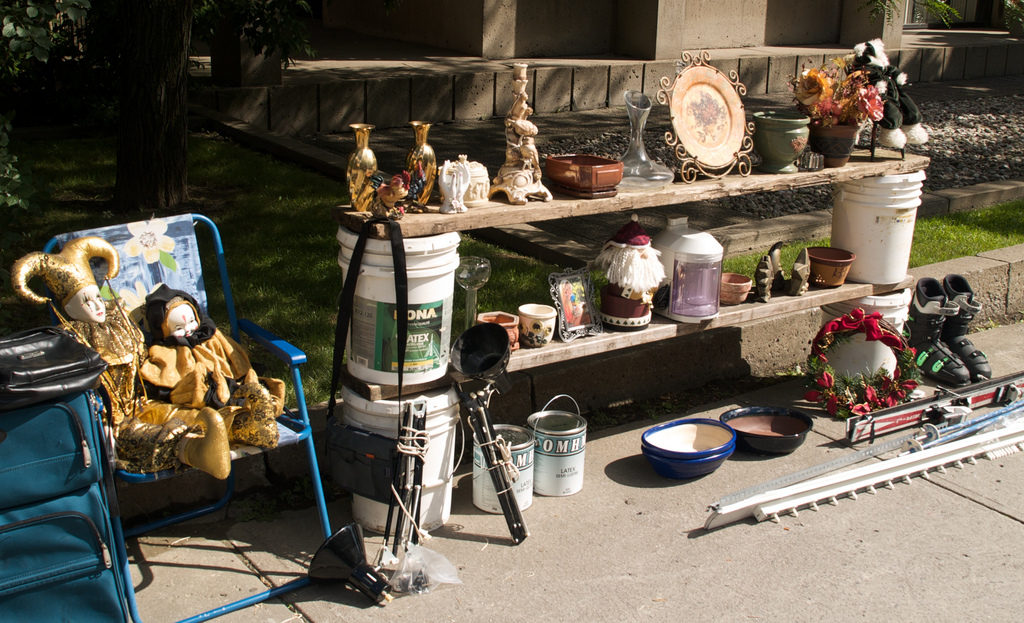The blustery days of winter eventually give way to spring, but never too soon. With the coming of spring, hope blossoms in the souls of those in the Valley who go garage saling every Friday and Saturday. An ad in the paper or on Craigslist or a homemade sign dangling from a telephone pole can prompt the ardent garage-saler to grab a few dollars and to head out to find second-hand treasures.

By definition, a garage sale—also known as a yard sale, a tag sale, a moving sale, or an estate sale–is usually defined as “a sale of used household goods or personal items held on the seller’s own premises” (Webster’s On-line). Garage sales should not be confused with rummage sales, jumble sales, or bazaars, as these types of sales are usually held by institutions to raise money for a particular charity or cause or person in need. Often, the latter types of sales are held in churches or community buildings, rather than at individual homes. A garage-saler is a buyer at garage sales; a garage-seller is the vendor from whom a garage-saler buys.
Garage sale and yard sale are usually used synonymously. However, there is a slight difference between the two—which may be obvious from their names. Garage sales are held indoors, and yard sales are usually held outdoors. This differentiation can matter greatly in the case of inclement weather. Yard sales are sometimes cancelled at the last minute, delayed, or postponed if inclement weather occurs at the time the sale is scheduled. Garage sales are usually ignorant of the weather.
The people who are planning garage sales usually spend weeks gathering the items to be sold. This often involves cleaning out attics, basements, closets, and drawers and finding those items that are no longer needed/wanted. Then, these sellers pick the dates and times for their sales. Friday and Saturday mornings are the prime-times for these sales. Often, a sale is posted to run from 8:00 am until noon; some 8:00 am until question mark, thus leaving the closing time to be open-ended. The most feverish of the garage salers will sometimes pay little attention to the posted opening time of the sale and, intentionally, arrive quite early—some as early as an hour and a half beforehand. Such pests are often referred to as “early-birds,” and they can be so annoying as to prompt sellers to post in their printed ads—NO EARLY BIRDS!
This warning, however, does not always deter those who wish to secure early bargains. Sometimes, the garage-seller will refuse to sell to early-birds and remind them, not unkindly, of the posted opening time of the sale. Sometimes, the early-birds will linger until opening time, but sometimes they will fly elsewhere and not return. The advantages to the early-bird are several. First of all, the best selection of items will occur early-on, and this is the primary impetus behind the early arrival. Yet, there are those more savvy early-birds who use the early arrival as a sort of “surprise attack” upon the vendor who, being still bleary-eyed from getting up early or being not yet organized, may sell an item too hastily and too cheaply just to prompt the early-bird to wing away!
The vendors also usually spend a great deal of time placing price-tags on each item to be sold. This process is quite time-consuming and can be costly if the seller buys the self-adhesive labels for each item. Other times, the items will be divided into tables/sections, in which all items are the same price. The more seasoned of those hosting the sale will not price out anything in advance, but will wait to be asked by the prospective buyer the price of the item. One who studies human behavior can often tell by the way the prospective buyer holds the item in question just how much it is valued. Yet, if the seller gives a price that the buyer finds too high, a couple of scenarios might play out.
The first is the process of haggling: the prospective buyer will make a counter-offer, and then the seller can accept or reject the lower price for the item. If the seller accepts the lower price, the buyer is happy; if the seller rejects the lower price, the buyer is unhappy. Then, the buyer may suggest a price in between what was initially offered by the seller and suggested by the buyer. For example, if the price of a used crystal vase is $6.00 initially, the buyer may suggest $4.00 as a counter-offer. When the four-dollar offer is rejected, the prospective buyer may then suggest “splitting the difference” and offer $5.00. In most cases, the seller will shrug her/his shoulders and utter, “Okay.” Transaction completed, the garage-saler will be hurriedly off to the next, most-proximate sale.
The second scenario that might occur is that the prospective buyer will simply put the item down from where it had come and huffily depart the sale without another word. This situation does not benefit the buyer, obviously; however, it does allow the seller to reconsider the price the next time he/she is asked about the used crystal vase. Perhaps, in reconsideration, the seller may realize that $6.00 was too much to ask and then may lower the price a dollar or two without having to change a sticker, as would be the case when an item sports a price-tag.
Some buyers will often gather numerous items from a sale and then ask if the seller will take a lump-sum for the items, rather than what the price would be if each item were to be sold separately. And sometimes the seller will accept the lump-sum so as not to have to spend time adding everything up. And sometimes not. Early in the day, the seller may think that later on she/he might be able to get the price as listed; closer to the closing hour, the seller might happily accept the offer so as not to be stuck with the unwanted items and have to pack them up again and have to find them a new home—because “they are NOT going back into the house!” Putting the said items back into the house would defeat one of the original purposes of the sale—to purge oneself of the unwanted/unneeded items.

When left-over garage sale items are gathered up at the conclusion of the sale, decisions must be made about their disposition. Most often, these items are taken to the Goodwill, the Salvation Army, or St. Vincent de Paul’s thrift stores. There are several major benefits to making donations to these nearby charitable organizations. One is getting rid of the residual items so that they will not find their ways back into the house. Another is that these charitable organizations will provide the donor with a slip of items donated, and this can be used for tax-deductions the following tax year—if one itemizes. If large items, like furniture, mowers, carpets, etc., cannot be transported by the vendor, often an arrangement can be made with the charities to have the items picked up and hauled off. And, obviously, those who buy regularly from thrift stores at low prices will be pleased with the increase in purchasable options.
In the Valley, there are number of garage sales every weekend beginning around the middle of March (weather permitting) and running through the middle of November, slowly diminishing in number as the garage-sale season wears on. Some local communities hold annual sales, and the garage-salers not-so-patiently await their arrivals. Community sales are the best venues for the garage-saler because there are many houses in a limited area, and time is saved by not traveling great distances from house to house. Community sales are also favorable because they can be walked rather than driven through. Oftentimes, food and drink vendors—usually children with lemonade, cookies, and hot dogs—tempt the garage salers, who often give the toothy-grinned tykes twice the asked priced or at least very large tips when purchases are made.
Several of the most anticipated annual community sales in our area comprise Dimmeydale, Mil Acres, Mount View Drive (across from the Town and Country Animal Hospital), McCulley Estates (in Bethlehem), and Leewood Park (across from the Oglebay Park Driving Range/Ski area). Most garage-salers will park their vehicles at either end of the community borders and walk through these venues. Often they will bump into one another along the way and give reports regarding worthwhile residences to visit and “junk shops” to be avoided or brag about valued “finds.” During pleasant weather, these venues take on the spirit of a county fair, and the pedestrians will leisurely amble from house to house and chat with the vendors and the other garage-salers—seemingly in no hurry to get anywhere at any specific time. These types often form little cliques, and they know one another by name, and they also know what their garage-saling friends are likely to be seeking out. The buyers who do walk quickly are on “missions,” and they probably would be better off driving through the community. These garage-salers are nearly professionals who try to buy cheaply and then resell later at double or triple the price. These types often own antique or curiosity shops or sell on eBay.
Dimmeydale has bi-annual sales each summer, and the first is usually the second weekend in May. Dimmeydale 1, as some of the regulars call it, is quite worthwhile; however, Dimmeydale 2 is a crap-shoot: time is easily wasted on this day as very few residences open for a second time that season. If one is going to Dimmeydale 1, she/he would be wise to take (or buy) an umbrella. It rains as frequently on that day as it does on Waynesburg, PA’s “Rain Day”—July 29th—about 83 percent of the time. Mil Acres, having so many participant vendors, is almost undriveable! A driver’s time is easily eaten up trying to find a parking place and trying to find an opening in the tight, one-way traffic or trying to find some way to turn around his/her vehicle. Mount View Drive is a pleasant walk half of the time—when going downhill, but it is a steep climb out, especially if one is carrying too many recently purchased treasures. McCulley Estates and Leewood Park are relatively large areas and usually have about twenty-some participating vendors; therefore, walking some distances and driving others is probably the best formula for success and efficiency.
There are also other locations in the area that have attractive sales as well, though they are not as populated as the aforementioned community sales. The towns of West Liberty and Bethany have annual sales, and they attract numerous buyers. Antiques are a likely find at these town sales. Additionally, Clinton Hills, Elm Street (in Woodsdale), and Longvue (or Long Vue, if you rely upon the arrowhead-shaped sign nearby) Acres Road. Clinton Hills attracts quite a few garage-salers because of the widespread belief that “rich people live there.” And “rich people,” in the lore of garage-saling, often sell unused, unopened items—some of which can be used as gifts for holidays and birthdays—at relatively low prices. Elm Street, for a small area, is an awaited venue—especially if the “Desperate Housewives” participate in it. They always have quality stuff, especially clothing and household goods, at the most reasonable of prices, and they will usually let the buyer win the haggling-game. They seem to be in it for the fun and socialization—not necessarily the money. And Longvue Acres sellers have many interesting and varied items for sale—many of which I have seen at previous garage sales earlier in the season. Walnut Avenue (in Woodsdale) used to have an annual sale which was quite popular among the garage-salers, but for some reason no one seems to get around to organizing it anymore.
In addition to the garage-sale venues already mentioned, a number of organizations around the Valley hold successful rumble/jumble sales. For instance, Oglebay Park has both a jumble sale (usually in the middle of March) and a clothing consignment sale each year at the garden center beneath the Palm Room, and both are very popular, if one uses the lengthy lines which amass before the opening time as an indicator. These venues usually open at 10:00 am, and the lines begin forming around nine-ish. The money made at these two venues usually are fund-raisers for particular benefits. Also, a number of churches in the area have several sales each season. Among the more popular ones are the following: Christ United Methodist at the corner of Washington Avenue and National Road (also excellent baked goods and jewelry), Elm Grove United Methodist Church on Kruger Street in Elm Grove ($1.00 per grocery bag deals and baked goods), First Christian Church on National Road (and baked goods), Fourth Street United Methodist in Wheeling, Lawrencefield Parish Church on Table Rock Road (my personal favorite with independent vendors, hot dogs, and cookies), Ruble United Methodist on Ruby Street (behind Figaretti’s), St. James Evangelical Lutheran Church on Chapline Street (great bargains on the last day), Saint Michael Angelus on National Road (both jumble sale and children’s clothing sales), Stone United Presbyterian on East Cove in Elm Grove, Triadelphia Methodist Church on Route 40, and Vance Memorial Presbyterian at the corner of Route 88 and National Road (almost too crowded at the onset, so sidling is the only method of movement among the rows of tables).
Additionally, a couple of schools have popular jumble sales, especially Triadelphia Middle School (usually benefitting school club travel) and Bridge Street Middle School in Elm Grove. Both have excellent baked goods for sale along with household items and clothing. Two senior-living communities, G. W. Petroplus Memorial Towers and Saint Paul Terrace, also have excellent rummage and baked goods sales. Bargains are plentiful at both sites due to the residents needing to “pare down” because of limited living spaces and well-meaning, gift-giving family members—just too much stuff which cannot be used or stored properly.
One annual garage sale deserves particular note because of its personnel and purpose. That sale is at the home of Rowena Baker on Damian Road in Woodsdale. About a dozen women, who comprise the PEO (Philanthropic Educational Organization) Sisterhood, give of their time and their own donations to put on a sale which benefits women who are struggling to meet their college expenses. All of their items are clean, organized, and reasonably priced. All of the proceeds from their sale go into the Sisterhood’s coffers to be redistributed to needy young females in order to promote their finishing their collegiate education. I personally know of two young women at West Liberty State College/West Liberty University who have been recipients of scholarships and low-interest loans and who have, as a result of the PEO Sisterhood’s assistance, earned their degrees and are now gainfully employed. Both of these women, most likely, would have dropped out of school had it not been for the PEO Sisterhood’s financial help. This is a sale not to miss, not only for the items offered but for the philanthropic benefits mentioned.
(And, yes, I know that there are many other garage/yard sales and jumbles/rummage sales in the Valley; however, I have chosen the aforementioned as good examples and not as a comprehensive list. Should you wish to put in a plug for your own or your institution’s sales upcoming this season, please just respond to this article in the comments section.)
In sum, whether one is a garage-saler for profit or for fun or for charitable support, there are nine key considerations in being successful: price, price, price; time, time, time; and location, location, location! With this in mind and with spring on the horizon, the time for saling the Valley in hopes of finding second-hand treasures draws near. Bon voyage, but caveat emptor!
Photo 1 by Eastlake Times via Flickr. CC BY 2.0.
Photo 2 by Sandra Cohen-Rose via Flickr. CC BY-SA 2.0.
Feature photo by sbringser.




